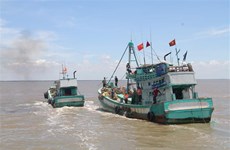Building new style rural areas creates new look to Thanh Hoa’s coastal district
The national target programme on new-style rural area building has given a facelift to coastal Nga Son district, the central province of Thanh Hoa, helping stabilise local livelihoods and alleviate poverty.
 Safe water melon farming model in Nga Son district, Thanh Hoa province (Photo: VNA)
Safe water melon farming model in Nga Son district, Thanh Hoa province (Photo: VNA)Thanh Hoa (VNA) – The national target programme on new-style rural area building has given a facelift to coastal Nga Son district, the central province of Thanh Hoa, helping stabilise local livelihoods and alleviate poverty.
After years of implementing the programme, 20 out of 26 communes in the district became new style rural areas, and 114 out of 163 hamlets met criteria of the programme.
According to Mai Van Cong, deputy head of the district’s agriculture bureau, during 2015-2019, the district has mobilsed over 2.8 trillion VND (121.2 million USD) to turn itself into a new style rural area, of which 193 billion VND came from the central and provincial budget, over 227 billion VND was sourced from the district budget, and the remainder was contributed by local residents and other sources.
The money was then used to develop local infrastructure, including the upgrade of 35 kilometres of inter-communal road and over 159 kilometres of inter-hamlet roads, repair of 85.99 kilometres of the irrigational system, and construction of 19 medical stations, 13 culture houses, and more than 3,400 water and latrine facilities.
Besides, the district has 71 out of 85 schools named national standard schools, and 23 communes and towns having national-standard health facilities.
Meanwhile, during 2016-2019, the district received 2.6 billion VND from the national target programme to help local residents branch out agricultural production. In fact, science-technology transfer and good production models have generated better incomes for farmers. Potato and water melon farming is the most outstanding models, which earn growers 97-120 million VND and 160-180 million VND, respectively, each hectare.
Hoa Van Su, a resident in Hamlet No.5, Nga Trung commune, said that he began cultivating clean vegetables and watermelon in net houses covering 1,000 square metres.
“Advanced technology has been applied, making the plants grow well. My family’s average income reaches 300 million VND each year”, Su said.
Meanwhile, Nguyen Van Hoan, residing in the same village, has been successful with his 900 square-metre area growing potato, water melon and vegetables. He gains average 80 million VND a year.
To date, the district is home to 281 operating businesses and 900 farms. There are 1,348 poor households, and 3,789 near-poor households. Income per capita is 35.1 million VND this year, nearly tripling the amount in 2011.
Nga Trung commune is an outstanding new-style rural area in the district. It won the status in 2016 with income per capita reaching more than 34 million VND.
Hoa Van Quan, Vice Chairman of Nga Trung commune People’s Committee, said that the commune has directed local people to shift to clean vegetable and water melon growing and safe husbandry models, helping them escape from poverty.
The commune has fulfilled all 19 criteria of the new-style rural building programme, and is striving to achieve all advanced criteria in 2020, he said.
In the coming time, Nga Son district will work to satisfy all criteria of the programme, aiming to become a new-style rural district next year.
A total of 4,402 communes nationwide (49.38 percent of all communes in the country) met standards for new-style rural areas as of June this year, heard a recent conference reviewing activities in the national target programme on building new-style rural areas in 2011-2020 and the allocation of resources and budget for the programme.
Seventy six districts of 34 provinces and centrally-run cities nationwide received recognition for meeting all criteria of the programme.
Notably, the northern province of Nam Dinh, the southern provinces of Dong Nai and Binh Duong and the central city of Da Nang have 100 percent of their communes earn the title.
The National Target Programme on New-style Rural Area Building, initiated by the Government in 2010, sets 19 criteria on socio-economic development, politics, and defence, aiming to boost rural regions of Vietnam.
The number of criteria was increased to 20 in 2015.
The list of criteria includes the development of infrastructure, the improvement of production capacity, environmental protection, and the promotion of cultural values.-VNA













